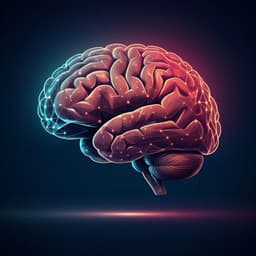
Medicine and Health
The anterior insular cortex unilaterally controls feeding in response to aversive visceral stimuli in mice
Y. Wu, C. Chen, et al.
This groundbreaking study reveals how right-side anterior insular cortex (aIC) CamKII+ neurons respond to aversive visceral signals, influencing food intake in mice. The team, including Yu Wu and Changwan Chen, uncovers a neural circuit that plays a pivotal role in regulating feeding behavior, offering new insights into addressing reduced food intake in pathological conditions.
~3 min • Beginner • English
Introduction
The study addresses how aversive, non-homeostatic visceral stimuli (e.g., malaise, inflammation, chemotherapy-induced sickness) alter cortical processing to regulate feeding. While hypothalamic circuits are well known to balance energy homeostasis, the cortical mechanisms, particularly in the anterior insular cortex (aIC)—a hub for interoception, gustation, and affect—are less defined in feeding control. Prior human and animal work shows aIC engagement by salient and noxious stimuli and its involvement in taste aversion and malaise, but a direct causal role in modulating food intake was unclear. The authors hypothesize that a specific population of right-hemisphere aIC CamKII+ excitatory neurons senses aversive visceral signals and suppresses feeding via defined projections to hypothalamic targets.
Literature Review
- The aIC integrates interoceptive and emotional information and responds to food cues and noxious stimuli (neuroimaging and lesion/stimulation studies). Altered insula activation is observed in eating disorders (bulimia, anorexia). Insula activation accompanies anorexigenic signals; stimulation induces visceral sensations (e.g., nausea), and insula damage blunts lithium-induced malaise and conditioned taste aversion.
- Despite extensive study of insula in aversion and interoception, its causal role in feeding has been ambiguous; lesions/inactivation did not definitively demonstrate direct control of food intake.
- Lateral hypothalamus (LH) is a key node for consummatory and motivational behaviors with bidirectional GABA/glutamate outputs; sources of excitatory cortical inputs to LH were less defined.
- Theoretical and empirical work suggests hemispheric lateralization in insular function (right dominance in interoception/negative affect) and lateralized roles of other limbic/cortical regions in affect and motivation, motivating investigation of left-right aIC asymmetry in feeding control.
Methodology
Animal models: Camk2a-Cre, Slc17a6-ires-Cre, and C57BL/6J mice (2–4 months). Male mice were used for behavioral tests; both sexes for tracing images. Standard housing (12-h light/dark), ad libitum food/water unless specified.
Aversive and metabolic manipulations: Intraperitoneal injections of lithium chloride (LiCl, 150 mg/kg), lipopolysaccharide (LPS, 0.1 mg/kg), cisplatin (4 mg/kg), cholecystokinin (CCK, 5 µg/kg), ghrelin (1 mg/kg), or saline; electric foot shock in a subset.
Viral tools and injections: Cre-dependent and promoter-specific AAVs expressing hChR2(H134R)-eGFP (optogenetic activation), eArch3.0-eGFP (optogenetic inhibition), hM3Dq-mCherry (chemogenetic activation), hM4Di-mCherry (chemogenetic inhibition), mCamKIIa-GCaMP6f (calcium indicator), eGFP/mCherry controls; Cav2-Cre for retrograde Cre delivery from LH; rabies-based monosynaptic tracing (AAV-DIO-TVA-EGFP + AAV-DIO-RG followed by EnvA-pseudotyped RG-deleted DsRed rabies) from LH vGluT2 neurons in Slc17a6-ires-Cre mice; CTB-Alexa555 retrograde tracer into right aIC for thalamic inputs; RNAscope for Slc17a6 mRNA.
Stereotaxic coordinates: Caudal aIC: AP +0.5 mm, ML ±3.85 mm, DV −2.82 mm (Bregma referenced). Rostral aIC and posterior insular cortex (PIC) targeted for controls. LH for terminal photostimulation/inhibition: AP −1.28 mm, ML ±1.23 mm, DV −5.28 mm. Fiber implants placed above targets (aIC or LH) after 2–4 weeks viral expression.
Opto/chemo manipulations: Photostimulation at soma or LH terminals with 473-nm light (−5 mW, 10 ms pulses, typically 20 Hz); photoinhibition with 532-nm continuous light (−10 mW). Chemogenetics: Clozapine-N-oxide (CNO, 1 mg/kg i.p.) acutely for behavior or chronically (q12h for 7 days) for body weight studies; in slices, 5 µM CNO to validate hM3Dq/hM4Di efficacy.
Electrophysiology: Whole-cell recordings in acute slices validated ChR2 excitability and eArch3.0 suppression in aIC CamKII+ neurons; mapped aIC-to-LH synapses by recording light-evoked EPSCs/IPSCs in LH at holding potentials −70/0 mV; CNQX applied to block glutamatergic EPSCs.
Fiber photometry: Unilateral GCaMP6f expression in right or left caudal aIC CamKII neurons; 488-nm excitation; ΔF/F computed relative to baseline; recorded responses to LiCl or cisplatin.
Histology and IHC: Fos immunostaining to map activation after injections or optical terminal stimulation; double IHC for Fos with CamKII or GAD67; quantification across predefined atlas levels.
Behavioral assays: Time-resolved feeding in 24-h fasted or fed mice (food intake, feeding time, approaches, latency); home-cage ongoing feeding interruption/evocation by light; real-time place preference (RTPP) for aversion/preference; taste sensitivity (quinine), water consumption, mating behavior, elevated plus maze, open field; heart rate under isoflurane for cardiac effects.
Statistics: Unpaired two-tailed t-tests for pairwise comparisons; one-way/two-way ANOVA with Bonferroni post hoc for multi-factor designs; normality via Shapiro–Wilk; nonparametric tests as needed. Data presented as mean ± SEM; significance thresholds P < 0.05, 0.01, 0.005.
Key Findings
- Aversive visceral stimuli selectively activate right aIC: LiCl, LPS, and cisplatin induced robust Fos in the right, but not left, aIC; e.g., LiCl: t22 = 4.027, P = 0.0006; LPS: t10 = 6.946, P < 0.0001; Cisplatin: t20 = 2.886, P = 0.0091. Fos+ cells localized to caudal right aIC (Bregma +1.26 to −0.02 mm) and predominantly agranular insula.
- Metabolic cues had minimal aIC effects: Ghrelin and CCK elicited weak, bilateral/diffuse Fos in aIC (n.s.). Feeding state (ad libitum, 24-h fast, refeeding) or foot shock did not activate aIC.
- Cell type: ~82.6% of LiCl-induced Fos+ neurons in right aIC co-expressed CamKII (excitatory), ~4.1% co-expressed GAD67 (inhibitory). AAV-CamKIIa labeling confirmed ~87.8% overlap of Fos with CamKII+ neurons.
- In vivo dynamics: Fiber photometry showed sustained activation of right (not left) aIC CamKII+ neurons after LiCl (one-way ANOVA F3,12 = 8.409, P = 0.0028) and cisplatin (F3,12 = 71.38, P < 0.0001).
- Causality—activation suppresses feeding: Optogenetic activation (20 Hz) of right caudal aIC CamKII+ neurons in 24-h fasted mice reduced food intake (t ≈ 2.385, P = 0.029), decreased feeding time (t17 = 4.259, P = 0.005), reduced approaches (t17 = 4.775, P = 0.0067), and increased latency to first approach (t17 = 3.408, P = 0.0034). Activation rapidly interrupted ongoing feeding (latency to stop: t20 = 10.7, P < 0.0001; inhibition rate: t17 = 19.64, P < 0.0001). Produced RTPP avoidance without affecting anxiety (EPM, OFT), water intake, mating, or heart rate.
- Site specificity: Activating right rostral aIC or right PIC CamKII+ neurons did not alter feeding (n.s.).
- Inhibition promotes feeding: Optogenetic silencing of right caudal aIC CamKII+ neurons (fed mice) increased food intake (t12 = 3.758, P = 0.049), approaches (t12 = 7.167, P < 0.0001), and feeding time (t12 = 7.995, P < 0.0001); evoked feeding in home cage (t12 = 20.14, P < 0.0001); induced place preference (t12 = 3.915, P = 0.0083) without affecting anxiety, water intake, or mating.
- Lateralization: Left caudal aIC CamKII+ activation did not affect feeding (food intake t12 = 0.369, P = 0.7187; approaches t12 = 0.988, P = 0.3426; feeding time t12 = 0.251, P = 0.8063), valence (RTPP), water intake, mating, or anxiety.
- Chemogenetics—chronic effects: Right aIC CamKII+ activation via hM3Dq + CNO suppressed feeding in fasted mice (two-way ANOVA: food intake F1,18 = 43.11, P < 0.0001; feeding time F1,18 = 32.82, P < 0.0001) and reduced body weight during chronic CNO (interaction F19,114 = 10.6, P < 0.0001). Inhibition via hM4Di + CNO blocked LiCl- and LPS-induced anorexia (LiCl F3,26 = 3.287, P = 0.0365; LPS F3,26 = 9.614, P = 0.0002) but not CCK-induced hypophagia (n.s.), increased body weight with chronic CNO (interaction F18,126 = 9.078, P < 0.0001), and rescued cisplatin-induced weight loss when targeted to right (not left) aIC (interaction F16,64 = 57.1, P < 0.0001).
- Circuit mapping: Right aIC CamKII+ neurons project strongly to LH; terminal photostimulation in LH induced Fos along LH A–P axis, with peak between −1.06 and −1.58 mm Bregma; slice recordings showed glutamatergic (CNQX-sensitive) EPSCs in LH with no IPSCs. Rabies tracing from LH vGluT2 neurons labeled CamKII+ neurons in right aIC; CTB injected into right aIC retrogradely labeled VPMpc neurons, 94.5% Slc17a6+ (glutamatergic).
- Projection function: Activating right aIC CamKII+ terminals in LH suppressed feeding (food intake t20 = 2.445, P = 0.0239; approaches t20 = 5.451, P < 0.0001; feeding time t20 = 5.814, P < 0.0001), interrupted ongoing feeding (latency t20 = 15.33, P < 0.0001; inhibition rate t20 = 14.31, P < 0.0001), and produced place avoidance; water intake and mating unaffected. Silencing right aIC→LH terminals promoted feeding and place preference without affecting drinking.
Discussion
The findings demonstrate that a specific, lateralized cortical node—the caudal right aIC CamKII+ population—detects aversive visceral/internal state signals and exerts potent, rapid control over both appetitive and consummatory phases of feeding. The unilateral right-sided activation by LiCl/LPS/cisplatin, coupled with the necessity/sufficiency tests (opto/chemo activation suppresses feeding; inhibition promotes feeding and reverses anorexia/weight loss), establishes a causal role for right aIC in emergency-response feeding suppression. Circuit mapping and functional terminal manipulations identify a glutamatergic projection from right aIC to LH vGluT2 neurons as a key effector pathway mediating hypophagia and aversive valence, consistent with LH vGluT2 roles in feeding suppression and negative reinforcement. The lack of effects from left aIC manipulation underscores hemispheric specialization in interoceptive-affective control of feeding, aligning with right-dominant insular functions for negative affect and interoceptive attention reported in humans. Together, these results bridge cortical interoceptive processing to hypothalamic feeding circuits, revealing how pathological visceral states can transiently override homeostatic drive to eat.
Conclusion
This work identifies a lateralized cortical–hypothalamic circuit—right caudal aIC CamKII+ neurons projecting to LH vGluT2 neurons—that senses aversive visceral inputs and suppresses feeding. Right aIC activation is sufficient to inhibit feeding and induce avoidance, while inhibition promotes feeding and rescues chemotherapy-induced anorexia and weight loss. The study advances understanding of cortical control over feeding under pathological conditions and highlights hemispheric asymmetry in insular function. Future research should delineate upstream inputs (e.g., thalamic/PBN sources and their lateralization), downstream LH targets mediating suppression (e.g., PBN, LHb, VTA pathways), molecular identity of aIC neurons, and translational relevance across sexes and species.
Limitations
- Species and sex: Experiments were in mice; male mice were used for behavioral assays, potentially limiting generalizability across sexes and to humans.
- Circuit scope: While the right aIC→LH vGluT2 pathway was defined, downstream effectors beyond LH were not directly mapped functionally; additional work is needed to identify the full output chain mediating hypophagia.
- Upstream inputs: Precise upstream sources and lateralization of aversive input to right aIC (thalamus/PBN subtypes) were not fully resolved and warrant detailed tracing/functional interrogation.
- Regional specificity: Although rostral aIC and PIC controls were negative, potential contributions of other insular subregions or mixed cell types within the caudal aIC were not exhaustively dissected.
- Behavioral breadth: While valence and anxiety were tested, broader affective/cognitive impacts and long-term metabolic consequences beyond body weight require further study.
Related Publications
Explore these studies to deepen your understanding of the subject.







